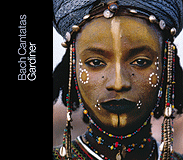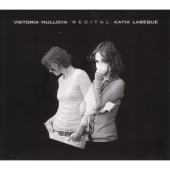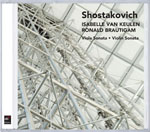|
You are reading the older HTML site
Positive Feedback
ISSUE
28
Notes of an Amateur November, 2006 - Part II
J. S. Bach, Cantatas, Vol. 7: BWV 25, 78, 17, 50, 130, 19, and 149. John Eliot Gardiner, Monteverdi Choir & English Baroque Soloists. SDG 124.
I would like to find something new to say about this brilliant ongoing series, if only to persuade some of you who are still not with it to get onboard. That Gardiner and his people were able to maintain their high level of energy and excellence over a two-year run, performing virtually every Sunday in churches all over Europe (and New York City), is an accomplishment in itself that calls for as much persuasive praise as I can muster. What this latest release brought to mind, once again, is the question of how much an artist's subject 'matter' affects the quality of the work; and equally important, how it ought to affect our enjoyment of it. The first disc of the two in this set presents three cantatas that use Christ's curing the leper as its text, interpreting the disease as an image of our sinful state. Not material that works for most of us these days, I expect. But to listen to what Bach makes of this and how profoundly I am moved by its eloquence and beauty reminds me of what novelist Henry James tells us: we must grant an artist his subject matter. In effect, if you understand how art works, what it essentially is, it is not the 'matter' that matters. Just about anything will do—anything that gives a particular artist access to his or her power to make art. Life seen through the lens of eighteenth century Protestant Christianity is what enabled Bach to see and express what is eternally true about us. The cliché that an artist should write about what he knows is absolutely true because that is the only 'matter' he knows intimately enough to see through and beyond. This music—I am listening to the famous soprano/alto duet in BWV 78 as I write this—is about passionate love in its richest form: when it involves two lovers aspiring to take their love higher, whatever form higher takes for you. More selfless while it still glories in the joyous and passionate union of two selves; or close to an ideal form that loses none of the intensity of the real; or closer to the contemplation and saving grace of Christ. Because it is great art and not a religious tract, this duet gets at the human experience that is at the heart of all three of these different forms of what the music makes us understand is, at the deepest level, the same aspiration. If you are a Calvanist or Lutheran, the specific doctrinal 'matter' is involved in the intensity of your artistic experience; if you are not a Christian or even religious, your experience is no less intense, just less doctrinally specific. When true art does what it does best, it moves through and beyond its 'matter,' which is why major works of art are subject to so many different interpretations. But what is permanent in them, their true grasp of human experience, exists in all of the interpretations. We grant Bach his Calvanist 'matter' and his art gives us the eternal human truth of what will appear to some as a mere instance of it. This statement could stand for any good performance of Bach cantatas, but only a few are able to make it truly compelling. And, to repeat myself once more, the energy and musical life that Gardiner and his forces bring to these cantatas sets his performances among the very best. The second CD in the set, as Gardiner patiently explains, is about angels—specifically, "For the Feast of St. Michael and All Angels." And not the sort of angels New Agers are looking for either. In these cantatas, angels are about the sense of confidence and wellbeing we feel when we have conquered (or constrained) those parts of us we least admire and brought ourselves into moral balance and wholeness. There is a militant aspect to these angels that underlines the formidable strength of the (natural) forces in us which pull us away from the fuller and more morally complex humanity to which we aspire. The view of humanity these cantatas express is the opposite of one which, to return to our New Age friends, encourages us to accede to our natures and follow our bliss. It is one that recognizes that who we naturally are is not necessarily who we ought or even want to be; that at the very least, that self is woefully incomplete. We are challenged to bring a different, more ambitious standard to bear. We need to expand and move beyond the selves that, as we moderns would put it, we have evolved into: there is more to life than hunting and gathering. And dominating and conquering and enabling our selfish genes. Again, the conflict between the attractive but fragile beauty of this higher standard and the strength of our natures is what accounts for the quality of the angels in this music. This is music that is quite beautiful but which also has a strong backbone! And it has never been played or sung better.
Recital: Viktoria Mullova and Katia LaBeque. Works for Violin and Piano: Stavinsky, Schubert, Ravel, Clara Schumann. Onyx 4015. Most of us know Viktora Mullova, one of the world's very few great violinists. Those who also know Katia LaBeque probably know her as half of the much admired piano duo of Katia and Marielle LaBeque. And now, some of us will know her as the fully equal half of this wonderful violin/piano duo. We are told in the album notes that these two musicians have played this 'recital' many times together. For those of us who are Mullova fans, the album is the latest in her rebirth as a recorded musician. And it is a fine one. To wit: Stravinsky's Suite Italienne. Mullova and LaBeque play this classic suite adapted from the composer's Pulcinella with more contrasting moods than I am accustomed to hearing in it. They make us more aware of the modern composer than the eighteenth century one from whom Stravinsky 'borrowed' its theme. They jump from lyrical to robust and back again, where others (Isabelle Van Keulen and Ollie Mustonen, for example) play within a narrower range of moods and at a slower pace to produce a more bittersweet, almost sentimental piece. I love the energy and directness of the Mullva/LeBeque approach and admire their willingness to make this utterly charming music new. Van Keulen and Mustonen have been my standard for years (there are several fine adaptations of the work for cello and piano too—Tashi's with cellist Fred Sherry is terrific); but there is room in our heads for this one too. Whether or not over time it will come to make Van Keulen/Mustonen sound too easy or whether, on the other hand, it will lose its freshness will be interesting. Mullova has a way of becoming definitive! Have you heard her Sibelius Violin concerto recently? Schubert, Fantasie for Violin and Piano, D. 934. The Schubert piece is programmed immediately after the Stravinsky, and it takes us to another musical world entirely. What is consistent is the sense of control Mullova and LaBeque maintain over the music. It is exquisitely lyrical, but the voices of the two instruments are strikingly firm and clear. This music, which could easily become soporifically sweet in softer, more indulgent hands, comes to us like a Keats poem: as crisp as it is romantic. As the piece progresses, I am reminded of Alain Plainès' Schubert Piano Sonata cycle, in its ability to forcefully and effectively re-imagine this music. It sometimes takes major musicians to persuade us that a piece of music in the canon is truly significant. Mullova and LaBeque do that with this work. Note: Planès' cycle has just been reissued as a boxed set by Harmonia Mundi. Do not miss this probably last chance to get it. If you care about classical piano music, this will become one of your greatest treasures. www.positive-feedback.com/Issue22/Alain_planes.htm Ravel, Sonata for Violin and Piano. Raval needs the same firmness and clarity to make his case as Schubert does. Boulez has shown us this with the composer's orchestral music; Mullova and LaBeque do it for this staple of the violin and piano repertoire. LaBeque blooms in this work—the piano is no mere accompanying voice in this sonata. And Mullova's violin bristles as forcefully as it sings. Another arresting and satisfying performance. Clara Schumann, Romance for Violin and Piano. The recital ends with a brief rapturous romance by the renowned wife of Robert Schumann, who, as this music reminds us, has a strong musical personality of her own. Both Mullova and LaBeque bring an eloquent restraint to the work, which suits its modesty and beauty. It is a piece that is over almost before it begins, leaving a fine taste in our ears. This is a wonderful recording, with sound as good as the music-making.
Shostakovich, Violin Sonata, Viola Sonata. Isabelle Van Keulen, violin; Ronald Brautigam, piano. Challenge Classics CC 72071 Speaking of Isabelle Van Keulen, where has this recording been? The notes tell us it was recorded in 1992, at a time when these two sterling Dutch musicians were putting out an excellent series of CD's of modern French music for violin and piano on Koch International. But I don't remember ever seeing this one. Apparently it was rescued from Koch's archives by Challenge Classics, the heroic (Dutch—that may explain why), firm that adopted and have just completed the Ton Koopman (also Dutch) Bach Cantata cycle. Now if they would rescue Van Keulen's and Mustonen's Stravinsky album (Philips nla), we'd call them the record company of the decade! It is opportune to have this recording of the Shostakovich sonatas at hand so soon after hearing them orchestrated by Kremer and Bashmet. (www.positive-feedback.com/Issue27/amateur3.htm). Van Keulen and Brautigam bring out the yinny side of the Violin Sonata, which robs it of none of its eloquence while opening up new possibilities. In their hands it becomes subtle, anxious, almost French. Van Keulen's touch is light and sinewy, while Brautigam's piano walks alongside in the same spirit. Their approach takes on vigor in the faster, more dramatic second movement, but is still less forceful and robust than some others I have heard. Van Keulen and Brautigam skip and prance rather than charge through this movement. In the final (Largo) movement, their soft touch returns. It firms up as the music intensifies but never becomes visceral. This is more mental than physical Shostakovich. It is unfashionable to play Shostakovich this way, but clearly this way is in the music to be found, and it an appealing one. It as if the musicians knew that a bolder approach would, as I suggested in the Kremer/Bashmet review, burst this music apart. As those familiar with the Viola Sonata will hear, Van Keulen's and Brautigam's approach is less of a departure from the norm. Because she does not dig into her instrument, the work's intensity is down a notch or two from a Bashmet say. But its solitary, sardonic cast remains intact. A kinder, gentler Shostakovich? Or a subtler, more refined and introspective one? Coming A New Joy; Orthodox Christmas, Paul Hillier with Estonian Philharmonic Chamber Choir, HM. Bach, Cantatas for the Third Day of Christmas, John Eliot Gardiner, SDG. Bach, Cantatas Volume 22 (final volume), Ton Koopman, Challenge Classics. Shostakovich, Quartet No. 15; Gubaidulina, Rejoice!, Kremer, Phillips, Kashkashian, Ma, CBS. Shostakovich, Complete String Quartets, Sorrel Quartet, Chandos. Schubert, Quartets Nos. 13 and 14, Tackacs Quartet, Hyperion. Schubert, Piano Sonatas 4,7,9,11, 13-21. Alain Planès. HM. Ligeti, Special Edition, Wergo. Mendelssohn, Complete Quartets, Pacifica Quartet, Cedille. System used for these auditions: Audio Note CDT 2 II transport and Dac 4.1 Balanced Signature, Audio Note M6 preamplifier and Neiro amplifier, Audio Note AN-E/SPx SE speakers. Cabling is Audio Note Sogon, AN-Vx, and SPx. Bob Neill, in addition to being an occasional equipment and regular music reviewer for Positive- Feedback Online, is also proprietor of Amherst Audio in Amherst, Massachusetts, which sells equipment from Audio Note, Blue Circle, Manley Labs, and JM Reynaud, among others.
|



